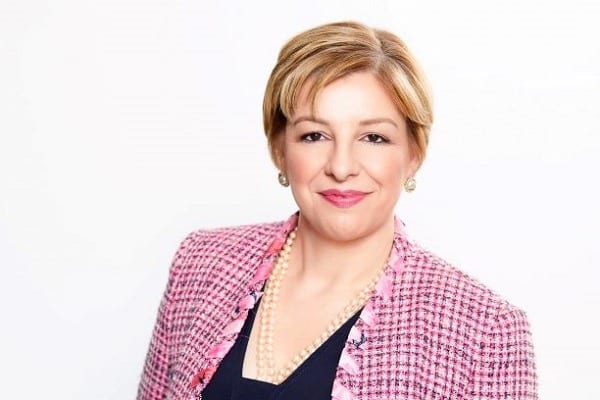Starting in the role in 2018, she says her path to the top has been aided by the encouragement of other women, as well a shift in her own mindset to believing that she too could aspire to leadership positions.
“I often looked upon leaders as being some super-human species that I couldn’t possibly aspire to,” she says in the below Q&A. “It is only when I got up close that I saw that I wasn’t so different. The only difference, often, was their self-belief and willingness to throw their hat in the ring, so to speak.”
She says her key message to all women is that we all have the ability to aspire to leadership. Take opportunities that come, learn along the way, and then aspire to the next level in your own way. “We don’t all have to be amazing networkers, public speakers, or any other stereotypes that we associate with leadership.
“Particularly as women, we can do leadership in our own way, we can go about things differently, we can demystify leadership and mentor those around us. It is not an exclusive club made just for some.”
Under her fresh leadership at State Schools Relief, the organisation has already quickly flourished in a way that not-for-profits normally don’t. An Ambassador Program, collaborating with corporate sponsors including Bank Australia and Bank First, working with 180 schools to raise approximately $124,000 and distributing items to school students exceeding $5 million, are just some of her achievements since taking on the role.
Her leadership has also helped ensure that in 2018, the State Schools Relief was able to impact underprivileged children in 83% of all Victorian state schools.
Below, Sue Karzis answers some questions from Women’s Agenda on how she landed the CEO gig and her advice to other women, as well as how she managers her day as a single mum of two.
Was there a key turning point in your career that put you on the path to leadership positions and eventually a CEO role?
The key turning point came when I worked for a particular female manager who really encouraged me to step into leadership and supported me with opportunities, professional development and reinforcing my belief that I was and could be a leader.
The opportunities afforded to me under her management allowed me to see that I could be a leader and take on leadership roles. Once in and around other leaders, I saw that I did have leadership qualities and potential.
Just like the research which shows that it is difficult for young people to aspire to tertiary education if none of their family has attended university, I would argue that it is difficult to envision yourself as a CEO if you have not been around CEOs and other managers who are operating at that level. Once I was able to access other leaders, it reinforced my belief that I could step up to the next level of leadership, which for me, was a CEO position.
You have set a goal to positively impact 70,000 underprivileged school children in Victoria in 2019, can you share more on your plan to achieve this?
The plan to achieve these outcomes involves liaising with all Victorian state schools to ensure that they are aware of the support available to them. Applications for financial hardship, domestic violence and homelessness have increased exponentially over the last three years so at State Schools’ Relief we would like to be able to assist every family who requires our support. Last year alone, we assisted over 56,000 children and young people with school uniforms, shoes, calculators and other educational resources.
We have also started retailing our shoes to assist with funding our charitable applications and also retail our Student’s Choice uniforms to assist with fundraising.
Diversifying our business model to be sustainable into the future and achieve our goal to be able to assist over 70,000 underprivileged Victorian children and young people is a key strategic goal for SSR in 2019.
You have approached your CEO position with entrepreneurial zest. How did you go about this and why did you decide to do things differently?
This is the approach I have taken in all of the roles which I have held. I have always chosen roles where I could have an impact, so developing programs and marketing these is part of what I do.
At SSR, we can do a lot of things differently which will benefit our charitable work and allow us to expand the scope of what we do. I look at the current state of play, and then see what I can change, implement and improve.
SSR is a charity that was established during The Great Depression, but in order to be sustainable we have to look at our organisation differently. Uniform and shoe sales form a perfect alignment with our charitable work as they don’t require any new skills or investment, we are simply developing a social enterprise arm of the charity which will increase revenue and help fund our core charitable work.
You are the first female CEO of State Schools Relief and have a board of 75% women. What benefits do you believe this kind of shift in leadership can bring?
This shift in leadership is crucial for the generations of female leaders to come. Young women can’t aspire to leadership positions if they can’t see diverse examples around them. Before my tenure, every CEO of SSR was a former teacher or principal and somewhere in that narrative, women along the way didn’t think that this was a role for them.
The Board realised that broadening the scope of the role and opening it up to people with different types of industry experience might be beneficial to the organisation.
How has a lack of traditional experience in the not-for-profit sector impacted your fresh approach to leadership?
I think right from the beginning I felt really excited at the prospect of being able to change, shape and influence the organisation. The Board was aligned with the ideas that I had presented, so I was able to start making changes almost from day 1. I was not held back by the mindset of ‘this is how we have always done things” and whilst the changes may not have always sat comfortably with all of those around me, I was determined to try things, and be willing to fail. I felt that we couldn’t just continue to do things the way they had always been done. I love change and innovation and have always worked in roles where I developed new programs so I brought the same energy and passion to this role.
What are the transferable skills that you’ve brought to this role (outside of direct industry experience) and why do you think it’s helped you succeed?
The transferable skills that have assisted me are my big picture thinking – I love having a vision of where I would like the organisation to go and then planning for how the vision will be implemented. Within three months of starting in the role, we held a Strategic Planning Day which was attended by both Board members and staff. This was key in establishing our key strategic objectives and ensuring that everyone understood the how and the why of what we were planning on doing.
Relationship building and working with key stakeholders to understand what they need from the organisation and ensuring that we are working in alignment is crucial.
In the NFP space in particular, it is crucial to maintain and nurture relationships. I have learnt so much from talking to different people and often they have provided key information that I could utilise.
Why is it so important for women to say yes to opportunities and step into top jobs? What kind of impact can this have on younger generations, especially in closing the ‘aspirational gap’?
I think that most importantly, women need to see that they have all of the necessary qualities to step into leadership, and I speak from experience when I say that this can be a confidence issue. Before being in leadership roles I often looked upon leaders as being some super-human species that I couldn’t possibly aspire to. It is only when I got up close that I saw that I wasn’t so different. The only difference, often, was their self-belief and willingness to throw their hat in the ring, so to speak.
That is my message to all women – all of us have the ability to aspire to leadership – you take every opportunity that comes your way, you learn along the way and you continue to aspire to the next level – and we can do it in our own individual way – we don’t all have to be amazing networkers, public speakers, or any other stereotypes that we associate with leadership. Particularly as women, we can do leadership in our own way, we can go about things differently, we can demystify leadership and mentor those around us. It is not an exclusive club made just for some – it is for anyone who aspires to be a leader and is willing to make it known.
What does an average day look like for you when it comes to managing both the home and work front?
An average day is usually juggling the work and home fronts. I do have help from my family in terms of school drop offs and pick ups and my children understand that work is a need and always has been. As a single mother, I didn’t ever feel guilty, as it was just what I had to do. I try and take a practical approach to things with both work and home and always reflect on how lucky I am to be able to do both.



